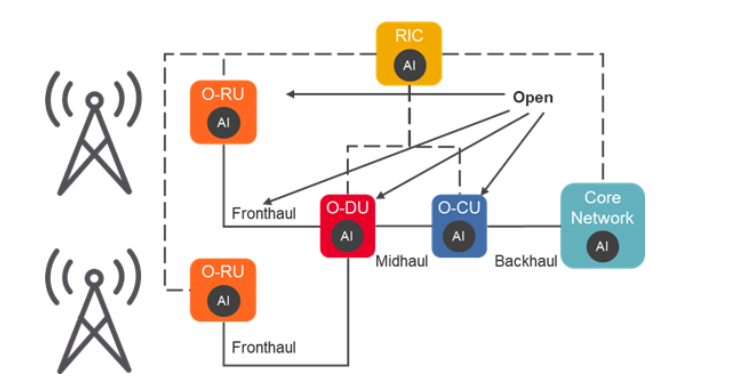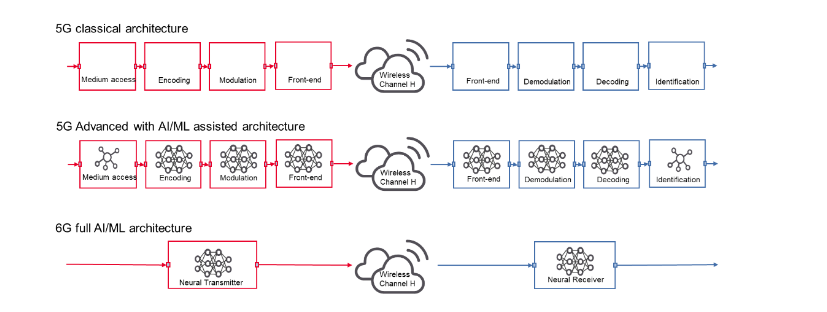
The artificial intelligence (AI) revolution has arrived. With the public release of applications such as ChatGPT, people have been able to experience firsthand the power and potential of deep neural networks and machine learning (ML). ChatGPT is a language model that has been trained using massive amounts of text data from the Internet and books to generate text that resembles that written by real people. This type of application perfectly embodies the advantages of artificial intelligence. It can continuously optimize the output in complex scenarios through a large amount of training data.
Wireless networks are inherently complex, generating huge amounts of data and increasing in complexity with the introduction of each new generation of technology. These properties make AI an ideal tool for optimizing wireless networks.
The application of AlI in 5G network
As 5G technology matures, AI and ML have been introduced into research by 3GPP (Third Generation Partnership Program), an international standards organization that develops standards for cellular technology. Ai is currently being considered for air interface improvements, including network energy saving, load balancing and mobility optimization. Because there are so many potential use cases for air interfaces, only a small subset of them has been selected for study in the upcoming 3GPP R18, covering channel state Information (CSI) feedback, beam management, and positioning. It is important to note that 3GPP does not develop AI/machine learning models. Instead, it seeks to create common frameworks and evaluation methods for deploying AI/machine learning models into different functions of the air interface.
In addition to 3GPP and air interfaces, the O-RAN Alliance is exploring how artificial intelligence/machine learning can be used to improve network orchestration and management. For example, the architecture of the O-RAN Consortium has one unique feature, called the RAN Intelligent Controller (RIC), which is mainly used to assist artificial intelligence and machine learning to optimize different use cases. RIC
You can manage near-real-time applications (xApps) and non-real-time applications (rApps). xApps for spectral efficiency and energy efficiency and rApps for network orchestration and management using artificial intelligence already exist. As the O-RAN ecosystem grows and matures, more xApps/rApps and applications optimized with RIC-based AI and machine learning will emerge.
Figure 1: ORAN network

6G network native AI technology
Although 6G is in its infancy, it is certain that artificial intelligence/machine learning will be a fundamental part of all aspects of future wireless communication systems. At the network level, although there is no formal definition, the term "AI native "is already widely used in the industry. One way to look at these AI-native networks - is according to RAN (Wireless Access Network) current virtualization technologies and convergence trends to infer the figure above (Figure 1). Each block in the network may contain AI machine learning models, which may vary between different vendors and applications (Figure 2).
Figure 2: ORAN 6G network

AI native networks can also be used to refer to networks built to run native AI machine learning models. Refer to the design flow below (Figure 3). In a traditional 5G network, the air interface is made up of different parts, each designed by humans. In the 5G-Advanced network, each part will utilize machine learning techniques to optimize specific functions. In 6G networks, the entire air interface may be designed by artificial intelligence using deep neural networks.
Figure 3: Evolution from integration with AI to AI-native networks

Artificial Intelligence/machine learning optimization
Drawing on the idea that AI1 machine learning can be used to improve network orchestration and management, 6G is pinning its hopes on using AI and machine learning to solve optimization challenges. For example, AI can turn components on and off based on real-time operation to reduce power consumption across the network. Today,xApps and rApps achieve this at the base station level by turning on and off energy-intensive components such as power amplifiers that are not working. However, AI's ability to quickly solve challenging computational problems and analyze huge amounts of data opens up the possibility of optimizing network performance on a larger scale, even at a city-wide or national scale.
The entire base station can be shut down during the period of low frequency of use, and the cell can also be reconfigured to use as few resources as possible to meet the real-time needs of users in a green, low-carbon, energy-saving and environmental protection way. It is not currently possible to reconfigure base stations and entire city networks in this way, and reconfiguring and testing any changes to network configurations typically takes days or weeks. Nevertheless, the prospects for different AI technologies are so vast that they remain a top consideration for infrastructure providers.
Conclusion
The application of artificial intelligence in wireless networks will not wait until 6G networks appear. Active research is underway across the ecosystem to develop new models and integrate these into existing and future wireless communication systems. However, these models are still new and need to be evaluated for their rigor and reliability.
Properly training AI models on different data sets, quantifying their improvements over traditional techniques, and defining new testing methods for AI-driven modules are all critical steps that must be taken as new technologies are adopted. As AI models and testing methods and technologies mature, there is no doubt that AI will revolutionize the wireless communications industry in the next 5-10 years.
About US
Heisener Electronic is a famous international One Stop Purchasing Service Provider of Electronic Components. Based on the concept of Customer-orientation and Innovation, a good process control system, professional management team, advanced inventory management technology, we can provide one-stop electronic component supporting services that Heisener is the preferred partner for all the enterprises and research institutions.
